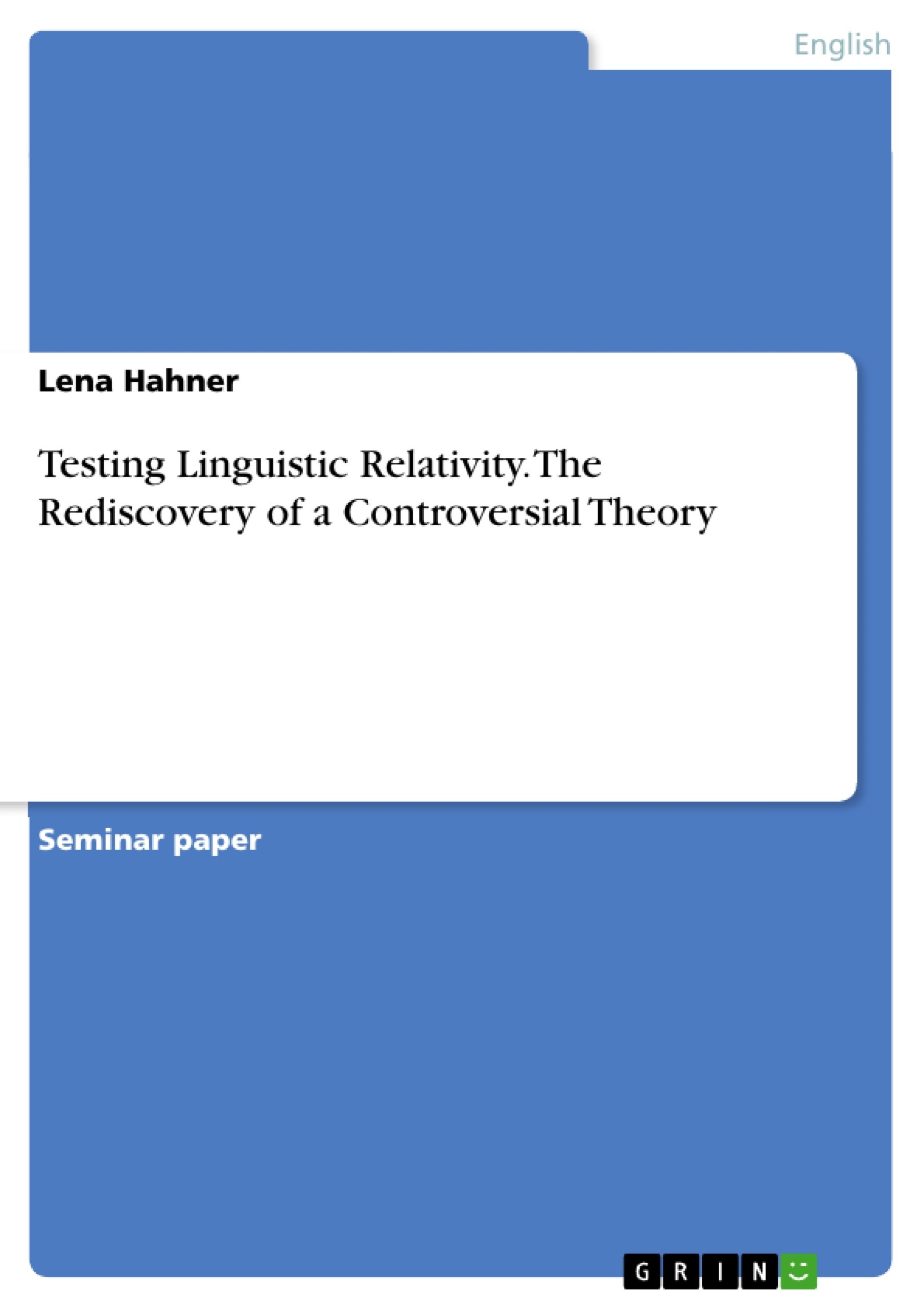This term paper deals with different approaches in linguistic relativity research, proving the thesis that the question whether linguistic relativity does or does not exist cannot be answered with a simple yes or no, but that the answer lies in between.
The theoretical framework will be provided by an overview of the theory of linguistic relativity, whose history of origins will be introduced briefly in the beginning, followed by a review of its criticism. Subsequently, two studies will be presented and interpreted, one trying to prove and one trying to disprove the hypothesis
Inhaltsverzeichnis (Table of Contents)
- I. Introduction
- II. The Sapir-Whorf-Hypothesis – a Short History of a Controversial Theory
- II.1 The Sapir-Whorf-Hypothesis
- II.2 Review of the Theory of Linguistic Relativity
- III. Opposing and Supporting Linguistic Relativity – Two Studies
- III.1 Disproving Linguistic Relativity: Altarriba/Tse (2008) in response to Boroditsky (2001) and January/Kako (2007)
- III.1.1 Design and Method
- III.1.2 Results
- III.1.3 Discussion and Conclusion
- III.1.4 Interpretation
- III.2 Proving Linguistic Relativity: Boroditsky/Gaby (2010)
- III.2.1 Design and Method
- III.2.2 Results
- III.2.3 Discussion and Conclusion
- III.2.4 Interpretation
- IV. Conclusion
Zielsetzung und Themenschwerpunkte (Objectives and Key Themes)
This paper examines the ongoing debate surrounding linguistic relativity. Its objective is to demonstrate that the question of whether linguistic relativity exists cannot be answered with a simple "yes" or "no," but rather lies in a nuanced middle ground. This is achieved by exploring the history of the theory, its criticisms, and by presenting and interpreting two contrasting studies—one attempting to disprove and the other to prove the hypothesis.
- The history and development of the Sapir-Whorf Hypothesis.
- Criticisms leveled against the theory of linguistic relativity.
- Analysis of empirical studies supporting and refuting linguistic relativity.
- Examination of the influence of language on perception and thought.
- The complex relationship between language, thought, and cultural understanding.
Zusammenfassung der Kapitel (Chapter Summaries)
I. Introduction: This chapter introduces the central question of linguistic relativity, referencing Wittgenstein's assertion that the limits of language define the limits of one's world. It sets the stage by briefly outlining the history of the debate, highlighting both the enthusiastic acceptance of the theory in the 19th century and the subsequent critical studies that challenged its deterministic aspects. The introduction establishes the paper's thesis: that the existence of linguistic relativity is not a binary proposition but a more nuanced and complex issue. The chapter concludes by outlining the paper's structure and approach, which will involve examining relevant studies that both support and refute the hypothesis. The introduction sets the framework for a nuanced exploration of the topic and positions the research within the larger context of linguistic and philosophical debates.
II. The Sapir-Whorf-Hypothesis – a Short History of a Controversial Theory: This chapter delves into the origins and evolution of the Sapir-Whorf Hypothesis. It traces the theory's roots to the Romantic era and the work of Wilhelm von Humboldt, emphasizing the early belief in the limitless diversity of languages and their potential influence on thought. The chapter then introduces the contributions of Edward Sapir, who expanded the theory of linguistic relativity to include the concept of linguistic determinism. The chapter also acknowledges the significant criticism the hypothesis faced, highlighting the turbulent history and ultimately setting the stage for a more balanced reassessment of its merits and limitations. The summary of this section shows the evolution of the hypothesis and sets the context for the following studies.
Schlüsselwörter (Keywords)
Linguistic relativity, Sapir-Whorf Hypothesis, linguistic determinism, language and thought, cross-cultural communication, cognitive linguistics, empirical studies, Boroditsky, Altarriba/Tse, January/Kako, Wilhelm von Humboldt, Edward Sapir, Benjamin Lee Whorf.
Frequently Asked Questions: A Comprehensive Language Preview
What is the main topic of this paper?
This paper explores the ongoing debate surrounding linguistic relativity, specifically the Sapir-Whorf Hypothesis. It argues that the question of whether linguistic relativity exists is not a simple "yes" or "no," but rather a nuanced issue requiring a more complex understanding.
What is the Sapir-Whorf Hypothesis?
The Sapir-Whorf Hypothesis, also known as the theory of linguistic relativity, explores the relationship between language and thought. It suggests that the structure of a language influences the way its speakers perceive and conceptualize the world. The paper traces its historical development, from its roots in the Romantic era to its modern interpretations and criticisms.
What are the key themes explored in the paper?
Key themes include the history and development of the Sapir-Whorf Hypothesis, criticisms of the theory, analysis of empirical studies supporting and refuting linguistic relativity, the influence of language on perception and thought, and the complex relationship between language, thought, and cultural understanding.
Which studies are analyzed in the paper?
The paper analyzes two contrasting studies: Altarriba/Tse (2008), which attempts to disprove linguistic relativity in response to earlier studies by Boroditsky (2001) and January/Kako (2007), and Boroditsky/Gaby (2010), which aims to prove it. Each study's design, methodology, results, discussion, conclusion, and interpretation are examined.
What is the conclusion of the paper?
The paper concludes that the existence of linguistic relativity is not a binary proposition. Instead, it suggests a more nuanced and complex relationship between language and thought, highlighting the importance of considering empirical evidence and the limitations of simplistic interpretations of the Sapir-Whorf Hypothesis.
What is the structure of the paper?
The paper is structured into four chapters: an introduction outlining the central question and approach; a chapter detailing the history and evolution of the Sapir-Whorf Hypothesis; a chapter analyzing two contrasting empirical studies; and a concluding chapter summarizing the findings and implications.
What are the key keywords associated with this paper?
Key keywords include Linguistic relativity, Sapir-Whorf Hypothesis, linguistic determinism, language and thought, cross-cultural communication, cognitive linguistics, empirical studies, Boroditsky, Altarriba/Tse, January/Kako, Wilhelm von Humboldt, Edward Sapir, and Benjamin Lee Whorf.
- Citar trabajo
- Lena Hahner (Autor), 2016, Testing Linguistic Relativity. The Rediscovery of a Controversial Theory, Múnich, GRIN Verlag, https://www.grin.com/document/358436




